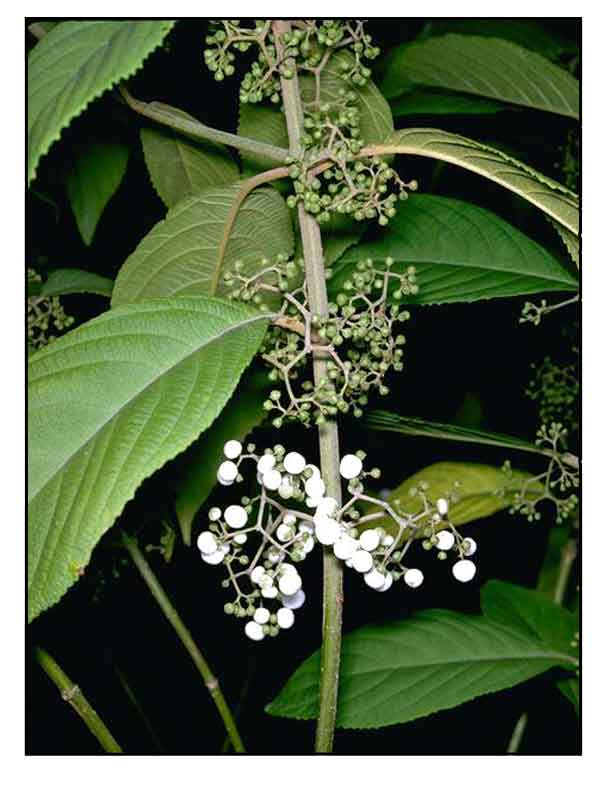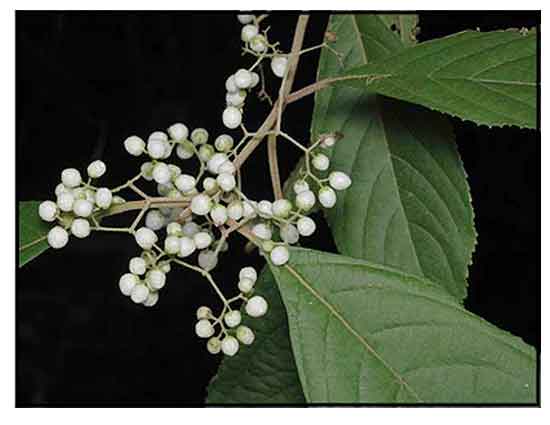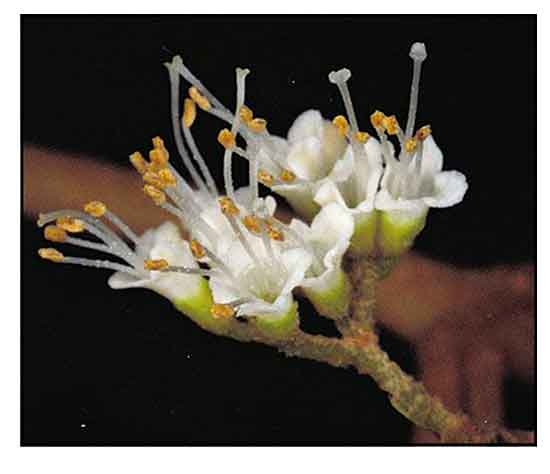 Gen inf Gen inf
- Callicarpa (beautyberry) is a genus of shrubs and small trees in the family Lamiaceae. The temperate species are deciduous, the tropical species evergreen.
- The genus comprises about 150 species, which are mainly distributed in East and South-East Asia, followed by tropical and temperate America, tropical Australia and some Pacific Islands. The highest concentration of species is in the Philippines and Cuba. (3)
- Etymology: The genus name Callicarpa derives from Greek words kalli, meaning "beautiful" and karpos, meaning "fruit". The specific epithet derives from Latin longifolius, meaning long-leaved. (4)
Botany
Callicarpa longifolia is a shrub 2-3(-5) m tall. Branchlets 4-angled, nodes with a transverse scar. Petiole slender, 0.5-1.5 mm; leaf blade narrowly lanceolate to oblong-elliptic, 8-20 X 2-6 cm, adaxially glabrous, base cuneate to narrowly cuneate, margin serrate, apex caudate-acuminate to cuneate, midvein and lateral veins abaxially very prominent. Cymes 2-3 cm across; peduncle slender, 0.5-1.5 cm. Calyx cup-shaped, ca. 1 mm, truncate to minutely 4-dentate, gray puberulent. Corolla pale purple, ca. 2 mm, slightly puberulent. Stamens 2-3 X as long as corolla; anthers ovate, ca. 1 mm. Ovary puberulent. Fruit ca. 1.5 mm in diam., stellate pubescent. (Flora of China)
Distribution
- Native to the Philippines.
- Also natrive to Andaman Is., Assam, Bangladesh, Bismarck Archipelago, Borneo, Cambodia, China, Christmas I., Hainan, Himalaya, Jawa, Lesser Sunda Is., Malaya, Maluku, Myanmar, New Guinea, Nicobar Is., Queensland, Sulawesi, Sumatera, Taiwan, Thailand, Vietnam. (1)
- Growing primarily in the wet tropical biome.
 Constituents Constituents
- Phytochemical screening of roots yielded alkaloids, flavonoids, saponins, and triterpenoids. (7)
- Study of leaf essential oils showed dominance of sesquiterpene hydrocarbons (63.0) and oxygenated sesquiterpenoids
(29.4). (8)
- Phytochemical screening of crude extract of leaves
yielded alkaloids, phenolics, flavonoids, and steroids. N-hexane fraction contained alkaloids, flavonoids, and steroids, while ethyl acetate fraction contained alkaloids, phenolics and flavonoids. (see study below ) (9)
- Phytochemical screening of dried leaves yielded saponins, flavonoids, steroids, tannains, glycosides, and phenols. Study yielded total flavonoid content of 7.995 w/w QE.
(13)
Properties
- Studies have suggested antibacterial, wound healing, antidiarrheal, antihyperlipidemic, antioxidant, mosquito larvicidal, analgesic, cytotoxicity activities.
Parts used
Leaves, roots.
 Uses Uses
Edibility
- In the early 20th century the bark was used by Japanese living along the Johnston River in north Queensland as a substitute for piper leaves to chew with the masticatory concoction of betel nut and lime. (14)
Folkloric
- Roots used to treat diarrhea.
- In Malaysia, leaves used for poulticing and for rubbing over the body in fever; also applied to swellings. Decoction of leaves drunk for colic, for fever, and after childbirth. Infusion of roots used for treatment of syphilis. Various plant preparations used for treatment of sprue. (2)
- In Indonesia, decoction of roots drunk for treatment of diarrhea and colic. Pounded leaves used as poultice ingredient applied to mature boils and ulcers. Leaf infusion drunk has depurative after parturition. (2) Leaves used for the treatment of syphilis and kidney disease. (•)
- In East New Britain, leaves applied to wounds and mouth ulcers and to reduce fever, swellings, and bruises. Leaves or roots used internally to treat diarrhea. (2)
- The Dayak Tunjung tribe, an indigenous Kalimantan tribe, use roots for treatment of colds and inflammation. (7) Plant used for treatment of acne, swelling, wounds, diarrhea, diabetes, and for lowering cholesterol.
- In China, leaves used for treatment of wounds; in Vietnam, plant used for treatment of fever, diarrhea, abdominal pain, and as postpartum tonic. (8)
Others
- Fish poison: Pounded leaves added to water used to stupefy fish.
Studies
• Antibacterial / Wound Healing / Leaves: Study evaluated the antibacterial and wound healing activity of karehau (C. longifolia) leaves ethanolic extract and gel preparation. Results showed antibacterial activity with MIC 64 µg/mL against P. aeruginosa and S. aureus. In bacterial infected wounds, there was decrease pus by day 6 decrease erythema score by day 9. Leaf gel concentration of 5, 10, and 20% showed wound healing by days 10, 9, and 7 respectively. (5)
• Analgesic / Leaves: Study evaluated the analgesic activity of ethanolic extract of leaves using doses of 150, 300, and 600 mg/kbw on while male mice (Mus musculus) with pain induced by acetic acid 0.5% (ip). Ibuprofen was used as control. Results showed dose dependent analgesic effect. (6)
• Mosquito Larvicidal / Leaf Essential Oil: Study showed leaf essential oil to be rich in (E)-caryophyllene (28.0%) and ß-selinene (13.2%), which showed larvicidal activity against Ae. aegypti with 24-h LC50 of 37.4 µg/mL. (E)-caryophyllene was relatively inactive with LC50 of 93.7. (8)
• Antioxidant / Cytotoxicity / Leaves: Study evaluated extracts of C. longifolia for phytoconstituents, antioxidant, and cytotoxity by brine shrimp lethality assay against Artemia salina. The n-hexane fraction showed highest toxic activity with LC50 of 90.05 ppm against Artemia salina. The ethyl acetate fraction showed highest antioxidant activity by DPPH assay with IC50 of 38.94 ppm. (9)
• Antihyperlipidemic / Leaves: Study evaluated the ability of kerehau ethanol extract in reducing lipid levels, lipid ratios, and number of foam cells in blood vessel walls in invivo and exvivo experiments on male Wistar rats with high-fat feed and 25% fructose for 45 days. The kerehau ethanol extract at dose of 75 mg/kbw was able to reduce TC levels (63.63), increase HDL (30.47), reduce lipid ratios (cardiac risk ratio 2.09) and atherogenic coefficient (1.09) and reduce the number of foam cells. (10)
• Antidiarrheal / Leaves: Study evaluated an ethanol extract of sangkareho (Callicarpa longifolia) leaves for antidiarrheal activity in castor oil-induced diarrhea in mice, using doses of 200, 300, and 400 mg/kbw. Loperamide was used as standard. Results showed the 400 mg/kbw dose showed greater antidiarrheal activity than loperamide. (11)
• Antibacterial Against Staphylococcus aureus / Leaves: Study evaluated the anti-Staphylococcus aureus inhibitory activity of Hati Tanah (Angiopteris Sp) tubers and sangkareho (Callicarpa longifolia) leaves in concentrations of 1, 5, 10, and 15%. Ethanol leaves extract showed inhibitory zones of 1, 2.68, 3.9, and 6.2 mm. (12)
Availability
Wild-crafted. |

![]()



 Gen inf
Gen inf

